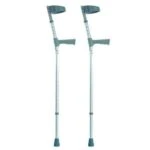If you get a leg injury, your doctor might suggest you to use crutches. Now using crutches can be a blessing. However, if you have not chosen the suitable crutches, then it can be an awkward, scary, and painful experience. Let us know more about these crutches and how you can make using them a pleasant experience.
Types of Crutches
Underarm Crutches: These are the most common types of crutches. They are placed in your underarm for use. Initially, they can be discomforting and tricky to use.
Forearm Crutches: They are also known as elbow crutches. They have a cuff that goes around your forearm and a handle for your hand to grip on. If you have to use crutches for a longer period of time then forearm crutches are the ideal choice. You can also add Walking Stick Ferrules to your crutches to make it anti-slippery.
Forearm support crutch: They have a padded forearm and adjustable handles. It will provide more support and comfort from the crutches. They are also called platform crutches or arthritic crutches.
Common Challenges With Crutches
Crutches is a tool that is usually used while recovering from a leg injury or condition. You might face some challenges while using traditional crutches. Here are they.
Walking With Crutches
Initially, walking with crutches can be a little challenging. So try to take short steps. Allow your body to swing forward while you support yourself with your hands. Crutches can get caught on things easily. So make sure you have a wide area around you. Make sure you look forward and not down at your feet as you walk.
Taking the Stairs
Taking stairs while you use crutches can be scary if you have to do it for the first time. Let us guide you on how you can do it.
Going Up Stairs
- Firstly, stand close to the step and ensure that your crutches is on ground level.
- Bring the injured foot up the stair with all your weight on crutches. Then take the crutches up to the step.
- Repeat this for each step until you reach your destination.
Going Down Stairs
- Hold the injured leg and hop down each step on the other leg.
- Make sure you support yourself with the crutches held on the next lower step.
- If you are doing it for the first time, make sure you have someone to assist you first if you have lower upper body strength.
Body Ache
After using crutches for a few days or using them incorrectly, some parts of your body might feel sore. Here are the types of pains you might go through and some tips to save you from the pain.
Sore Armpits
After using crutches your armpits hurts. Don’t they? To prevent yourself from sore armpits you need to use it correctly. Position the armrest below the armpits and not into your armpits. You can also add extra padding to the armrest and the grips. Also, make sure the armrest is as high as it should be. To measure it, stand straight and the top of the crutch should reach about 1-2 inches below your underarms.
Shoulder Pain
Shoulder pain is quite common and it doesn’t have a simple solution like adding extra padding or adjusting the height. If you have shoulder pain that is because you let most of your weight fall to the top of your arms. Instead, you should try to divide the weight evenly between hands, arms, and upper body. To figure out this, you can observe how your body feels when you use crutches so that you can figure out how to distribute the pressure.
Rib Pain
Rib pain can be because your crutches are sized incorrectly, due to which you hunch over and strain your core more than you should or you are using crutches at the wrong angle. You can resize your crutches 1-2 inches below your armpits and handgrips at the level of your hips. Also, make sure you position the crutch tips approximately 12 inches away from your feet.
Conclusion
Crutches are not that complex once you figure out the correct way to use them. If you are planning to use them for a longer time, invest in elbow crutches as they give the extra support and are more comfortable to use than the traditional crutches. Also, do not forget to add Walking Stick Ferrules to your crutches as an added safety precaution.



